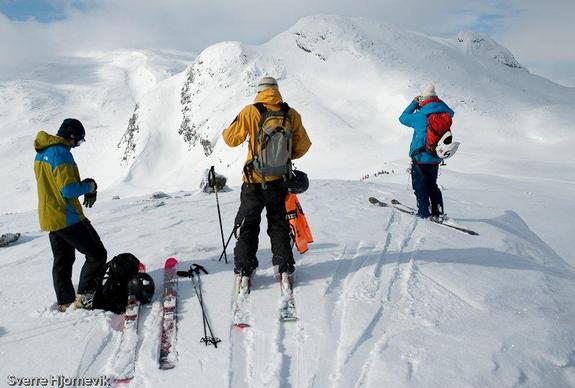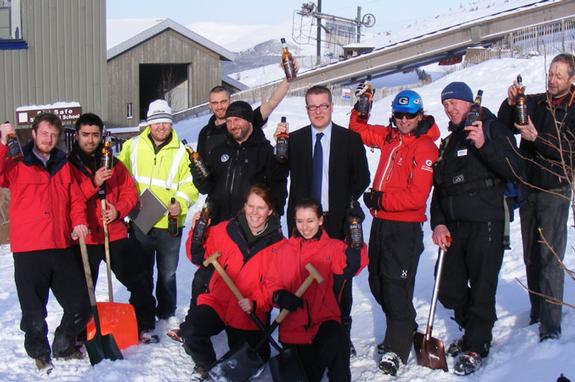World snow update - 10th feb
Whistler is ready, Olympic Snowboard venue Cyprus Mountain to host events as planned despite warm weather. US overtakes Europe For Deepest Snowbase in the world. Another few feet in the Alps. More than 40 die worldwide in avalanches in the past week.
www.Skiinfo.co.uk reports that heavy snow across North America, dubbed ‘Snowmaggeddon’ by media there, has resulted in travel chaos, but has also seen the country’s highest accumulated snow depth at Kirkwood in California overtake Europe’s deepest non-glacier accumulation for the season to date at Chamonix, both a few centimeters over four metres (13.3 feet).
Not every part of north America is experiencing great snow cover, unfortunately one of the few losers in the current snowy forecast is 2010 Winter Olympic snowboarding and freestyle skiing venue Cypress Mountain, close to Vancouver, which is battling with warm weather and a resulting lack of snow. Whistler, further north, has declared itself Games ready.
In Europe conditions have quietened a little after heavy snow at the end of last week which means conditions are generally excellent across most of the continent.
However avalanche danger is high in many areas off piste, with Italy suffering a number of deaths, leading to the possible introduction of legislation to levy large fines for those who ski or board in areas with an avalanche danger warning and of imprisonment for people who also set off avalanches.
Greater death tolls were reported in Iran (8 people) and India (17 soldiers) after extreme weather conditions brought heavy snow followed by strong winds creating unstable conditions.
In Europe, it has snowed a lot on the French mountains throughout the past week, with the heaviest snow leading up to the weekend. The snow is continuing today and is expected to continue for the next few days. Up to 60cm (2 feet) has been reported over the last week with resorts like Meribel, La Plagne and le Grand Bornand all reporting big falls.
The Vosges region, one of the lower mountain area for ski resorts in the country has received a particularly notable covering of up to 50cm (20 inches) at 1,200m. At Gerardmer, one of the region’s leading ski areas, Fabrice Clair, manager of the resort, told Skiinfo, "It has snowed more than 50cm on one day, greatly increased the snow depth which had been very thin at the beginning of winter. It’s now 1.2m (4 feet) in place thanks to artificial snow, but there is an average layer of natural snow from 50 to 60cm over the entire ski area."
Across France as a whole Chamonix Mont-Blanc has the top snow depth of 4m (13.3 feet) with Oz en oisans and Vaujany below Alpe d’Huez at 3.2m (10.6 feet), Flaimne and La Clusaz have 2.9m.
Switzerland also witnessed snowfalls last weekend. Arosa an Klosters in Grisons were among those issuing powder alarms on Saturday. Even more snow fell in the Valais with Champoussin receiving 60 cm (two feet) in only 48 hours. The resort issued just another powder alarm this morning because of a further 30cm (one foot) snowfall, as did its neighbour in the giant Portes du Soleil ski region, Morgins.
The Swiss WSL Institute for Snow and Avalanche Research SLF expects 10-20 cm of new snow for Switzerland’s’ northern slopes and for Lower Valais this afternoon – but also “widespread considerable avalanche danger”.
The deepest snow depths in Switzerland are at Lötschental and Engelberg with 262cm/245cm (8-9 feet) respectively . Andermatt, Saas Fee, Laax and St. Moritz each have two metres or more. All of them had some new snow in the last week.
Austria too has had a lot of fresh snow in the past week.
Martha Schultz of Mölltal glacier’s lift compay told Skiinfo the ski resort had 40cm (16 inches) of new snow last weekend so there were “very good conditions” on the slopes. “But please don’t ignore the current avalanche situation,” she added. On Sunday 30cm (a foot) of new snow in 24 hours had caused a powder alarm for the glacier, which currently has the greatest snow depth in Austria – three and a half metres *12 feet).
Willi Krüger of Pitztaler Gletscherbahnen told Skiinfo, “On the Pitztal Glacier the snow cover, which was already great, was topped by 30cm of fresh snow in 48 hours at the weekend. You can only call this ideal conditions”.
Sölden got 27 cm of new snow last week. They have a snow cover of 192cm (over six feet) on the glacier today. For this afternoon and for tomorrow more new snow is expected in Austria.
To the north, the heavy snow falls of last week lessened a bit in Germany last week. Still there was up to 53cm (nearly two feet) of new snow in seven days in Upper Bavaria. Ofterschwang in the Allgäu region had 33cm (13 inches) in a week. Yesterday snow started falling again in Germany and weather forecasts say there is more snow to come today and tomorrow.
Italy has had a good deal of heavy snow across the country, leading to great powder conditions, but high avalanche risk. Monterosa has had some of the biggest falls of the past seven days with 72cm (2.4 feet) accumulated.
The Pyrenees are still looking very nice with more than 1.5m (five feet) of sbnow on the top of the slopes in Andorra.
More cold weather and snowfall are expected through the week there and in Spain, where the top ski resorts have reported powder snow conditions.
Formigal has some of the deepest snow in the area with 220cm depths and 136km of slopes open. It will celebrate the Pirineos Sur Winter Formigal this weekend, a fusion musical Festival with performances from the School of Samba da PraÇa, Dj Wagner Pa and Jazz Rap Band US3.
Sierra Nevada in the south of the country has the deepest snow in Spain however and is reporting 300cm (10 feet) on upper slopes and 99 km of runs open.
Scandinavia saw some of the biggest falls at the start of this week. In Sweden 11 resorts reported between 15 and 25cm (6-10 inches) during the past 7 days. The most was at Kappruet with 25cm but the region’s largest ski resort, Åre was only just behind on 24cm.
The biggest snow depth in the country at the moment is in Ramundberget with 117cm followed by Vemdalen with 115cm. The weather forecast looks promising with more snow in the south and far up north. Sween’s most popular radio show, Rix Morronzoo broadcasts live from Åre this week from 10-13 Feb.

Hemsedal, feb 2010
Photo: Hemsedal tourism
In Eastern Europe there’s been a few inches of fresh snow at most resorts and conditions are now good at most areas across the region with up to 1.5m (five feet) of snow on upper slopes at Bulgaria’s Bansko.
In Northwest Europe there’s still snow in Belgium and the Netherlands. The recent snowfall (this morning) led to mega traffic jams in Belgium of up to 900km, in part because trucks blocked tunnels in Antwerp and Brussels due to snow on the road and in the Netherlands the was a 380km traffic jam which is longer than the distance from the very south to the northern border of the country.
Snow Fun can still be found in the East and Southern part of Belgium where Nordic and Alpine resorts have built up to a 40cm (16 inch) snow layer. Alpine resorts Spa and Baraque Fraiture are leading, together with the Nordic resort Losheimergraben.
Across the North Sea all five Scottish ski areas remain open, with most receiving some new snow in the past week and Cairngorm continuing to have the deepest snow, although all resorts have good cover. Cairngorm staff were rewarded this week with a special commemorative bottle of whisky from a local distillery in recognition of their efforts to ‘dig out’ the ski centre from the heavy snow in January. Next week the resort will be organising torchlit descents to celebrate the Olympics.

Cairngorm whisky gifts, feb 2010
Photo: Cairngorm tourism
In North America there have been snowfalls at most resorts, particularly on the US West Coast in California and further north in Alaska, where Alyeska has had the biggest snowfall in the world over the past 7 days – 107cm or 3.6 feet. Other resorts across the West have had big falls of 2-3 feet, although the snow hasn’t been quite as abundant in Colorado and other ski areas in the Rockies, although most have had good falls there too.
More unusually large falls have been reported in South eastern US states like Virginia where ski areas have reported 50cm (20 inch) accumulations an there have been similar large falls in other southern US states to the west like Arizona and New Mexico.
Whistler, host venue for the men's and women's alpine skiing competitions, will athletes training on the Olympic courses from today. The first alpine competition is the Men's Downhill on February 13th, the first day of Games competition.
"International Olympic Committee delegates recently skied the course and were very pleased with the results," says Tim Gayda, Vice President of Sport for the Olympic organisers VANOC. "From the beginning of the season, VANOC and Whistler Blackcomb crews have worked hard together to prepare the courses to create a very dense base of snow that involved a massive snowmaking effort.
Add to that the incredible amount of natural snow that has fallen in Whistler this season, and we're now ready to deliver an Olympic-class alpine skiing venue that will live up to the reputation that the renowned Dave Murray Downhill course holds the world over. We look forward to debuting the spectacular new woman's course on Franz's Run. We're in to the home stretch on our final preparations."
Deep snow at Whistler Blackcomb is not unusual, but reaching the average annual snowfall (10.13 metres/ 33 feet) this early is truly unique. Since snow reporting began in the 1979/80 season, this is the first time that Whistler Blackcomb has received this much snow by the end of January. The prior record was set in 2006/07 when 945 centimetres or 31 feet of snow fell by January 31.
The news is not so good at Cypress Mountain, the Olympic venue for snowboarding and freestyle events, is continuing to battle to be Games Ready however, although Olympic organisers insist it will be. Cypress is close to Vancouver which has been unseasonably warm all year and most of the snow at resort level has melted. The venue has been using hay bales to build structures like the half pipe and has been trucking in snow to cover them, rather damaging the ‘green’ reputation the Games have been striving for.
With no good news on lowering temperatures as the Games get closer the organisers are now using a Sikorsky S64 Skycrane, the second largest helicopter in the world, to transport snow onto the Olympic competition areas. Snow from the upper regions of the mountain will be moved by the helicopter and transported to the areas they are needed.